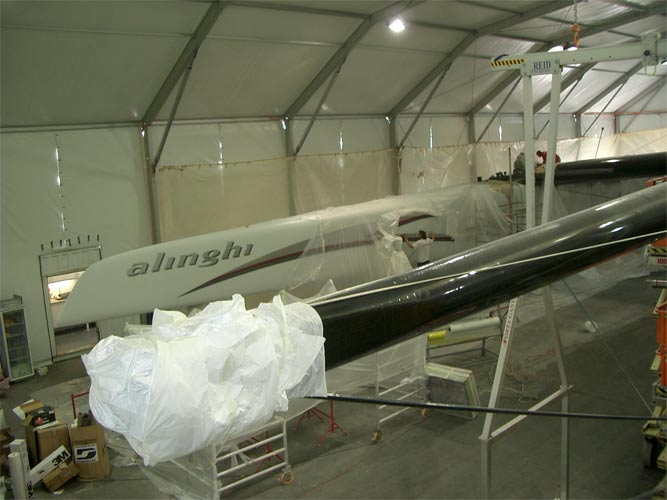Alinghi to helicopter lift America's Cup racing machine

Your support helps us to tell the story
From reproductive rights to climate change to Big Tech, The Independent is on the ground when the story is developing. Whether it's investigating the financials of Elon Musk's pro-Trump PAC or producing our latest documentary, 'The A Word', which shines a light on the American women fighting for reproductive rights, we know how important it is to parse out the facts from the messaging.
At such a critical moment in US history, we need reporters on the ground. Your donation allows us to keep sending journalists to speak to both sides of the story.
The Independent is trusted by Americans across the entire political spectrum. And unlike many other quality news outlets, we choose not to lock Americans out of our reporting and analysis with paywalls. We believe quality journalism should be available to everyone, paid for by those who can afford it.
Your support makes all the difference.The skies over the normally nondescript industrial area of Villeneuve on the southern shores of Lake Geneva will be darkened next Wednesday by a strange, menacing object, not unlike a praying mantis, slung under a serious muscle machine of a helicopter.
It will be a racing yacht, but not as we know them, its mission, like the black widow it resembles, is lethal, and, while it had been built in the name of sport and will carry the very non-commercial name of Alinghi, it is not for fun.
Nearly 4,000 miles away, in northern California, its target and rival machine is being given round the clock attention in Anacortes. For both, the prize is a trophy which originated in Cowes, on the Isle of Wight in 1851. When a marauding bunch of buccaneers from New York beat the best that Britain could muster, it became the America's Cup.
The event has been littered with rows and arguments ever since, but few more bitter than the 24-month clash between the current holder, Switzerland's Ernesto Bertarellli, and the self-made software magnate Larry Ellison. Both are rich and both hate any reference to this being a battle of the billionaires.
After taking the cup away from the Kiwis in Auckland in 2003 and successfully defending it against the again in 2007 Bertarelli thought he was in complete control of the whole event, but the blueprint he put up for the next event had a legal flaw in it which was pounced on by Ellison's BMW Oracle team. Several court hearings later and the two will meet in mortal combat next February. The Swiss are due to announce the venue no later than 8 August.
Stuart Alexander speaks to Murray Jones:
If it has stopped the cup in its tracks as far as the rest of the world, including Britain's Team Origin, is concerned, it has also spawned a boffins' paradise with huge budgets being thrown at producing the fastest machine that can stay in one piece for a maximum of three 20-mile races. The science lab atmosphere for the designers has been described by one of them, Britain's Nigel Irens, as "almost monastic."
Hence the tent that went up in Villeneuve, borrowing a NASA designation of a vehicle assembly facility, where every attempt was made to keep secret the nature of the beast that was so lovingly being assembled inside. After 100,000 hours of work, including some for the glitches in the build, that will start to be taken down today to reveal a piece of kit that looks both mean and fragile at the same time.
The twin hulls of the catamaran are nearly 90-foot apart when measured from outside edge to outside edge. But it has a huge, central carbon fibre impaler projecting forward which increases its sail carrying length to over 120 feet. There will be various masts, both a hard wing and soft sail versions, with leapfrog tests to decide which is the best way forward.
It will be so tall, perhaps 180 feet, with the area of a jumbo jet wing stood vertically. In addition there will be headsails which could be 1,000 square metres in area.
The crew of between 20 and 25 will have to dance from side to side as the boat zigzags up and down the course on a trampoline stretched between the hulls and the central structure with an area of about two tennis courts. When the wind heels the boat over, they will have to sit about four storeys high on edge of the flying hull. If it ever reached eight storeys then big trouble could be imminent.
Falling that far into a mass of deck hardware could lead to serious injury. Health and life insurance for the crews is a real problem, crash helmets, all fitted with intercom systems, are de rigeur. And the pressure exerted on a ball joint about the size of for crown green bowls will be well in excess of 100 tonnes.
Under that pivotal point is a cat's cradle of support and tension rigging. If one fails then the whole system could implode. No wonder that both teams have had to step gingerly when finding out just what these monsters of capable of delivering. And the Oracle boys are letting everyone believe that they have a newer boat, also a twin-hulled catamaran rather than their original three-hulled trimaran, nearly ready to launch.
If the good burgers of Villeneuve are pointing skywards asking is it a bird is it a plane and being told 'not it is a supermaran', then the trek through the Alpine valleys and down to the Mediterranean when initial testing is completed should be a logistical test case that will be of military proportions. In the meantime, stay well clear, on both sides of the French/Swiss border of lake Geneva/Lac Leman when this thing is trialling.
Join our commenting forum
Join thought-provoking conversations, follow other Independent readers and see their replies
Comments